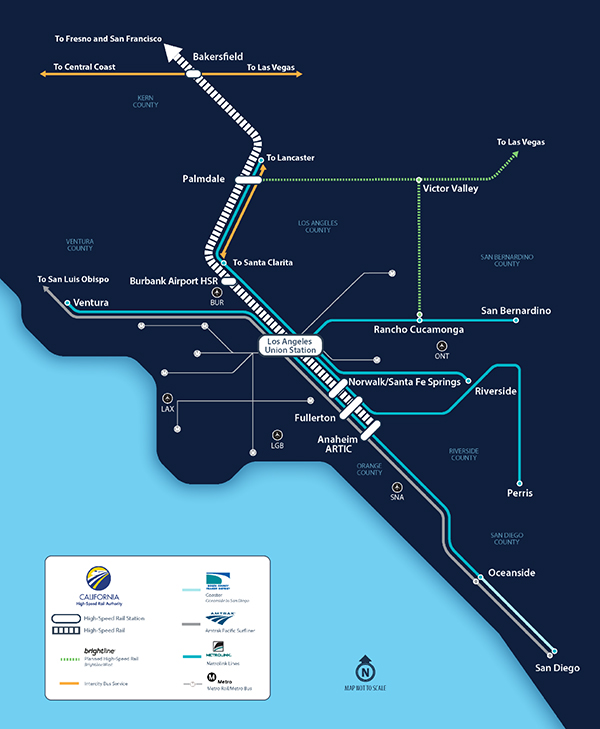Is the US Finally on Track to Build a High-Speed Rail Network?
The United States, home to 340 million people, boasts a vast system of transportation options including 71 interstate highways and over 5,000 public airports. However, one glaring absence remains — high-speed railways (HSR). As two significant HSR projects break ground, speculation arises on whether the US can catch up with fast train systems in nations like China, Japan, and across Europe.
Pioneering Routes Under Construction
Rick Harnish, the director of the High Speed Rail Alliance, remains cautiously optimistic about the developments. “We are finally seeing two HSR projects underway,” he notes, highlighting the challenging nature of these routes. The initial project stretches from San Francisco to Los Angeles, traversing California’s mountainous terrain, while the Las Vegas to Los Angeles line benefits from relatively flat land.
Apart from these routes, additional plans include a line from Portland, Oregon to Seattle, Washington, extending to Vancouver, Canada, and another connecting Dallas and Houston. However, Harnish expresses concern about slow progress in planning for the Portland-Seattle route and uncertainty regarding the Houston-Dallas line following the cancellation of a $63.9 million federal grant during the Trump administration.
Global Comparisons
In stark contrast, China’s high-speed rail network is projected to surpass 50,000 kilometers (31,000 miles) this year, while Europe boasts 8,556 kilometers of HSR, with Spain leading at 3,190 kilometers. The United Kingdom has one operational HSR line, connecting London St Pancras to the Channel Tunnel, while High Speed 2 is under construction from London Euston to Birmingham despite financial hurdles.
While definitions of HSR vary globally, the International Union of Railways suggests trains need to exceed 250 kilometers per hour (155 mph) to qualify. The lagging nature of US rail infrastructure raises questions: why does the country trail behind Europe and especially China?
Challenges in the American Landscape
According to rail industry journalist Will Doig, America’s car-centric culture complicates the HSR vision. “Many people either don’t see the need for it or object to it being built in their vicinity,” he explains. Furthermore, the US government’s reluctance to invest significantly in rail projects exacerbates the situation.
Adding to these challenges is the recent resignation of Amtrak’s CEO, Stephen Gardner, reportedly influenced by pressure from the White House. Currently, Amtrak does not operate any high-speed rail services, although it plans to introduce 28 new 160 mph NextGen Acela trains on its Northeast Corridor route by later this year. This line, however, only permits speeds above 150 mph on approximately 50 miles of its 457-mile span.
A Look at Global HSR Developments
The California High-Speed Rail project, set for completion by 2033, is spearheaded by the state government, while Brightline West, a privately-funded initiative connecting Los Angeles to Las Vegas, anticipates opening in 2028. Globally, 23 nations are currently engaged in HSR efforts.
Safety regulations for HSR operations are stringent, with an insistence on sealed corridors devoid of highway crossings. China continues to bolster its HSR network, eyeing an estimated total of 60,000 kilometers by 2030. Data from Denmark’s think tank, 21st Europe, indicates that cities receiving HSR connections experience an economic boost averaging 14.2%.
China’s ambition to expand its influence through HSR partnerships in Southeast Asia, as highlighted by Doig, raises questions about the geopolitical implications involved. Countries that accept Chinese investment risk becoming reliant on their benefactor, which could shift the region’s balance of power.
The Path Forward for US HSR
As Europe’s HSR network continues to develop, driven by long-term public infrastructure investment, calls for the US to adopt a new cultural mindset towards public transportation grow louder. Harnish argues for vital federal government involvement if the US is to develop a robust HSR system.
However, the US administration has retrenched support for the proposed Houston-Dallas high-speed line, with US Transportation Secretary Sean Duffy dismissing it as a misuse of taxpayer funds. Scott Sherin, an executive at French train manufacturer Alstom, which will provide Amtrak’s new trains, questions the US’s commitment to rail investment compared to other modes of transport. He also highlights potential obstacles to integrating HSR into densely built city centers like Dallas and Houston.
Despite reservations, Doig expresses a desire for collaboration with China in HSR development within the US, though he remains skeptical about such a partnership materializing in the current political climate.
Global HSR Investment Comparison
| Country | Total HSR Length (km) |
|---|---|
| China | 50,000+ |
| Spain | 3,190 |
| United Kingdom | 68 |
| European Union (total) | 8,556 |
As the transportation landscape shifts, America holds the potential for a future where high-speed rail could bridge vast distances and reconnect communities. Only time will tell whether political will and public appetite will finally coalesce to realize this vision.














